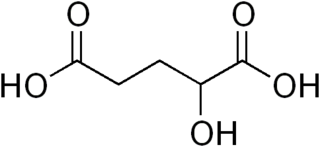
The citric acid cycle —also known as the Krebs cycle, Szent-Györgyi-Krebs cycle or the TCA cycle (tricarboxylic acid cycle)—is a series of chemical reactions to release stored energy through the oxidation of acetyl-CoA derived from carbohydrates, fats, and proteins. The Krebs cycle is used by organisms that respire (as opposed to organisms that ferment) to generate energy, either by anaerobic respiration or aerobic respiration. In addition, the cycle provides precursors of certain amino acids, as well as the reducing agent NADH, that are used in numerous other reactions. Its central importance to many biochemical pathways suggests that it was one of the earliest components of metabolism. Even though it is branded as a 'cycle', it is not necessary for metabolites to follow only one specific route; at least three alternative segments of the citric acid cycle have been recognized.

Isocitrate dehydrogenase (IDH) (EC 1.1.1.42) and (EC 1.1.1.41) is an enzyme that catalyzes the oxidative decarboxylation of isocitrate, producing alpha-ketoglutarate (α-ketoglutarate) and CO2. This is a two-step process, which involves oxidation of isocitrate (a secondary alcohol) to oxalosuccinate (a ketone), followed by the decarboxylation of the carboxyl group beta to the ketone, forming alpha-ketoglutarate. In humans, IDH exists in three isoforms: IDH3 catalyzes the third step of the citric acid cycle while converting NAD+ to NADH in the mitochondria. The isoforms IDH1 and IDH2 catalyze the same reaction outside the context of the citric acid cycle and use NADP+ as a cofactor instead of NAD+. They localize to the cytosol as well as the mitochondrion and peroxisome.

2-hydroxyglutaric aciduria is a rare neurometabolic disorder characterized by the significantly elevated levels of hydroxyglutaric acid in one's urine. It is either autosomal recessive or autosomal dominant.

Glutaryl-CoA dehydrogenase (GCDH) is an enzyme encoded by the GCDH gene on chromosome 19. The protein belongs to the acyl-CoA dehydrogenase family (ACD). It catalyzes the oxidative decarboxylation of glutaryl-CoA to crotonyl-CoA and carbon dioxide in the degradative pathway of L-lysine, L-hydroxylysine, and L-tryptophan metabolism. It uses electron transfer flavoprotein as its electron acceptor. The enzyme exists in the mitochondrial matrix as a homotetramer of 45-kD subunits. Mutations in this gene result in the metabolic disorder glutaric aciduria type 1, which is also known as glutaric acidemia type I. Alternative splicing of this gene results in multiple transcript variants.

In enzymology, a homoserine dehydrogenase (EC 1.1.1.3) is an enzyme that catalyzes the chemical reaction
In enzymology, a 4-phosphoerythronate dehydogenase (EC 1.1.1.290) is an enzyme that catalyzes the chemical reaction

In enzymology, a malate dehydrogenase (NADP+) (EC 1.1.1.82) is an enzyme that catalyzes the chemical reaction
In enzymology, a D-lactate dehydrogenase (cytochrome) is an enzyme that catalyzes the chemical reaction
In enzymology, a hydroxyacid-oxoacid transhydrogenase is an enzyme that catalyzes the chemical reaction
Long-chain alcohol oxidase is one of two enzyme classes that oxidize long-chain or fatty alcohols to aldehydes. It has been found in certain Candida yeast, where it participates in omega oxidation of fatty acids to produce acyl-CoA for energy or industrial use, as well as in other fungi, plants, and bacteria.

In enzymology, an (S)-2-hydroxy-acid oxidase (EC 1.1.3.15) is an enzyme that catalyzes the chemical reaction
In enzymology, an abscisic-aldehyde oxidase (EC 1.2.3.14) is an enzyme that catalyzes the chemical reaction
In enzymology, a 2-hydroxyglutarate synthase (EC 2.3.3.11) is an enzyme that catalyzes the chemical reaction

Phosphoglycerate dehydrogenase (PHGDH) is an enzyme that catalyzes the chemical reactions

D-2-hydroxyglutarate dehydrogenase, mitochondrial is an enzyme that in humans is encoded by the D2HGDH gene.

L-2-hydroxyglutarate dehydrogenase, mitochondrial is an enzyme that in humans is encoded by the L2HGDH gene, also known as C14orf160, on chromosome 14.

α-Hydroxyglutaric acid is an alpha hydroxy acid form of glutaric acid.
Phosphoserine transaminase is an enzyme with systematic name O-phospho-L-serine:2-oxoglutarate aminotransferase. This enzyme catalyses the following chemical reaction
In enzymology, a D-2-hydroxyglutarate dehydrogenase is an enzyme that catalyzes the chemical reaction
Metabolite damage can occur through enzyme promiscuity or spontaneous chemical reactions. Many metabolites are chemically reactive and unstable and can react with other cell components or undergo unwanted modifications. Enzymatically or chemically damaged metabolites are always useless and often toxic. To prevent toxicity that can occur from the accumulation of damaged metabolites, organisms have damage-control systems that:
- Reconvert damaged metabolites to their original, undamaged form
- Convert a potentially harmful metabolite to a benign one
- Prevent damage from happening by limiting the build-up of reactive, but non-damaged metabolites that can lead to harmful products










